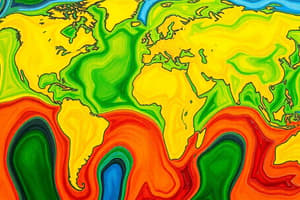Podcast
Questions and Answers
Who proposed the theory of continental drift?
Who proposed the theory of continental drift?
- Alfred Wegener (correct)
- Marie Curie
- Albert Einstein
- Isaac Newton
What was the name of the supercontinent that Wegener proposed?
What was the name of the supercontinent that Wegener proposed?
- Pangaea (correct)
- Gondwana
- Atlantis
- Lemuria
Approximately when did Wegener suggest Pangaea existed?
Approximately when did Wegener suggest Pangaea existed?
- 300 million years ago (correct)
- 10 million years ago
- 10 billion years ago
- 1 billion years ago
In what year was 'The Origin of Continents and Oceans' first published?
In what year was 'The Origin of Continents and Oceans' first published?
What was a major problem with Wegener's continental drift hypothesis at the time?
What was a major problem with Wegener's continental drift hypothesis at the time?
What did Wegener propose as a mechanism for continental movement?
What did Wegener propose as a mechanism for continental movement?
What force did early hypotheses propose that centrifugal force moved?
What force did early hypotheses propose that centrifugal force moved?
What evidence did scientists use to reject Wegener's idea?
What evidence did scientists use to reject Wegener's idea?
What did scientists think about the continents plowing through ocean basins?
What did scientists think about the continents plowing through ocean basins?
What evidence caused a few scientists to originally support Wegener?
What evidence caused a few scientists to originally support Wegener?
Who expanded Wegener's idea that there is thermal convection in the mantle?
Who expanded Wegener's idea that there is thermal convection in the mantle?
When do adjacent convection cells rise to the surface?
When do adjacent convection cells rise to the surface?
What technological advances eventually supported the theory of continental drift?
What technological advances eventually supported the theory of continental drift?
What is a convection cell?
What is a convection cell?
What happens to material in a convection cell, near the surface?
What happens to material in a convection cell, near the surface?
According to Wegener's hypothesis, what were the continents doing after Pangaea broke apart?
According to Wegener's hypothesis, what were the continents doing after Pangaea broke apart?
What does 'Pangaea' mean in ancient Greek?
What does 'Pangaea' mean in ancient Greek?
Why was Wegener's idea that continents moved ridiculed?
Why was Wegener's idea that continents moved ridiculed?
Flashcards
Continental Drift
Continental Drift
The hypothesis that continents were once joined in a single landmass and have since drifted apart.
Pangaea
Pangaea
The name of the supercontinent that existed about 300 million years ago, meaning "all earth" in ancient Greek.
Mantle Convection
Mantle Convection
A cycle in Earth's mantle where heated material rises, cools, and sinks, driving plate movement.
Convection Cell
Convection Cell
Signup and view all the flashcards
Wegener's Hypothesis
Wegener's Hypothesis
Signup and view all the flashcards
Study Notes
- Scientists recognize the need for all Earth sciences to contribute evidence for understanding the planet's past.
- Combining information from various Earth sciences is essential to determine the "truth".
- Any new scientific discovery might change the conclusions drawn.
- Alfred Wegener compiled evidence suggesting the continents were once joined in his book "The Origins of Continents and Oceans" published in 1915.
Wegener's Continental Drift Hypothesis
- Wegener proposed that continents drifted, likening it to icebreakers cutting through the ocean floor.
- Continents were joined into a single landmass called Pangaea ("all earth" in ancient Greek) around 300 million years ago.
- Pangaea broke apart, and continents drifted to their current positions.
- This is known as the continental drift hypothesis
Problems With the Hypothesis
- Wegener's continental drift idea was ridiculed due to the lack of a mechanism for continents moving through oceans.
- He suggested continents moved by centrifugal and tidal forces, similar to icebreaking ships.
- Calculations later showed these forces were insufficient to move continents.
- Continents "plowing" through ocean basins should be much more deformed.
- The hypothesis elegantly explained similar fossils and rocks on different sides of the ocean.
- Wegener needed a good "mechanism" to push his theory forward
Mantle Convection
- Thermal convection involves hot rock rising from the deep mantle towards the Earth's surface.
- The rock spreads, cools, sinks back towards the core, and reheats, forming convection cells.
- Arthur Holmes expanded Wegener's ideas, suggesting thermal convection in the mantle could be the driving force behind continental drift.
- A convection cell involves material being heated deep beneath the surface, causing it to rise due to lowered density.
- Near the surface, the material cools, becomes denser, and sinks.
- Adjacent convection cells rising to the surface could cause a continent to break apart.
- At the time, there was no evidence of thermal convection.
- Alfred Wegener died in 1930.
- The continental drift idea didn't gain traction for several decades.
Summary
- Alfred Wegener proposed that continents had been joined as a single landmass called Pangaea around 300 million years ago.
- Wegener's idea was ridiculed because he lacked a plausible mechanism for continents moving through oceanic crust.
- Calculations showed that his idea about centrifugal and tidal forces powering the continents could not be right.
- Wegener considered mantle convection, an idea expanded on by Arthur Holmes, as the driving force for continental drift.
- There was no evidence available to support the idea at the time.
Studying That Suits You
Use AI to generate personalized quizzes and flashcards to suit your learning preferences.




